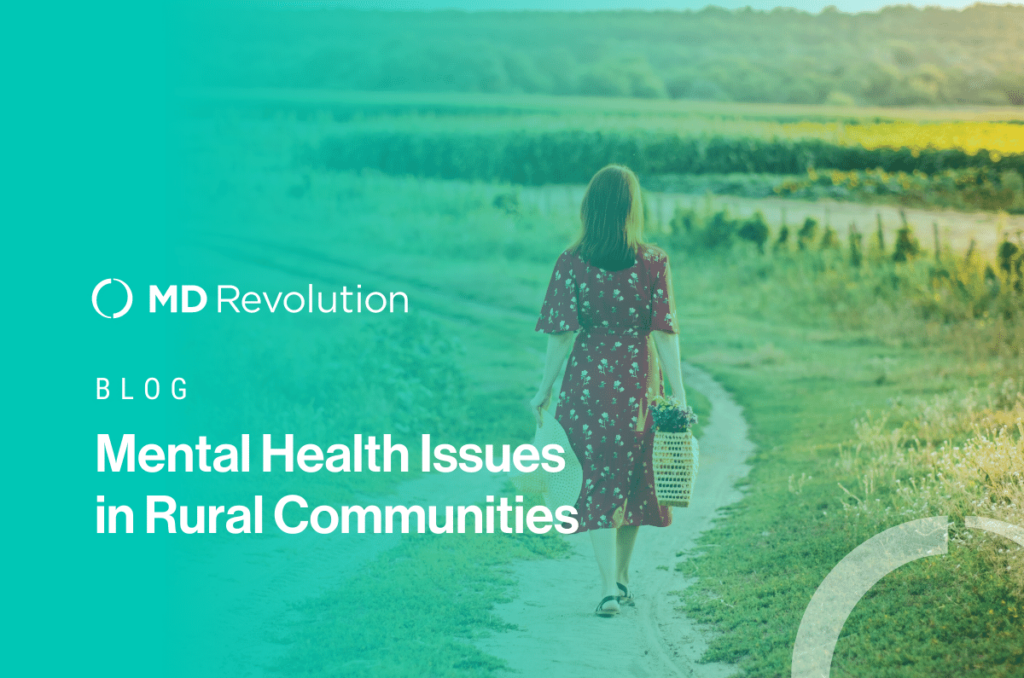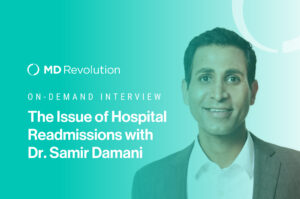As the covid-19 epidemic lingers in rural America, an older epidemic rears its head – the struggle for good mental healthcare.
Brought to you by our EHR partner, Azalea Health. Azalea Health is on a mission to empower underserved healthcare providers with a health IT platform that improves patient care and profitability.
Rural America, or rural areas, are defined by low density or geographically isolated areas and can range from 2,500 to 50,000 people. People living in these areas face unique challenges for patient care compared to the rest of the United States. For example, rural residents may face disparities due to:
- A disproportionate burden of chronic disease
- Restricted or limited access to quality health care
- Insufficient or lack of health insurance coverage
- Geographic isolation
- Drug abuse
- Lack of public transportation
- Poor infrastructure
- Low educational attainment
- Low health literacy
- Poverty and unemployment
- A smaller health care workforce and a lack of specialty care
- Limited availability of bilingual providers and interpreter services
- Cultural or social differences, stigma, and norms
But Covid-19 has brought with it new challenges, new struggles, and added hardships that pile onto ongoing issues, mental health being one of them.
The importance of mental healthcare has been brought to the forefront once again and providers are trying to rise to the challenge of delivering this specified care.
Rural Mental Health
Around one fifth of the United States’ population lives in a rural area, and out of those residents, around 7.3 million individuals have a mental illness. The prevalence of serious mental illness and psychiatric disorders is very similar between rural and urban areas, however adults in rural geographic locations receive help far less frequently, and often with providers with less specialized training.
Additionally, tied closely with mental health, and often seen in rural community residents, is a co-occurring mental illness with substance abuse. Throughout America as a whole, the opioid epidemic has been steadily spiking, and rural America is no exception. Many of those who have substance use disorders are commonly diagnosed with mental disorders or vice versa, “although there are fewer studies on comorbidity among youth, research suggests that adolescents with substance use disorders also have high rates of co-occurring mental illness; over 60 percent of adolescents in community-based substance use disorder treatment programs also meet diagnostic criteria for another mental illness” (National Institute on Drug Abuse).
Misconceptions and cultural stigma about mental illness are significant barriers to mental healthcare in rural areas. These factors may include:
- Lack of understanding, knowledge, and the conception of mental illness, and specific mental illnesses
- Prejudice towards people with mental health disorders because of fear and general lack of education on mental health
- Culture of self-reliance/resilience
- Secrecy of mental illness
- Fears of confidentiality and privacy in a small town setting
When many of these serious mental illnesses go untreated, patients can lose their jobs, homes, and their lives.
The Effects of Covid-19
The Covid-19 pandemic, though seemingly over for some, but ongoing for others, has had a major impact in our lives- how we interact with others, changes in routine, and changes in the workplace. These challenges have been stressful, overwhelming, and public health actions like social distancing have made some feel isolated or lonely.
Stress and anxiety have statistically risen; As of January 2021, 41% of adults reported symptoms of anxiety and/or depressive disorder. “Prior to the pandemic adults in poor general health (which may reflect both physical and mental health) continue to report higher rates of anxiety and/or depression than adults in good general health.For people with chronic illness, in particular, the already high likelihood of having a concurrent mental health disorder may be exacerbated by their vulnerability to severe illness from COVID-19” (kff.org). Such is the concern for rural adults, as chronic illness and general physical health concerns are more prevalent compared to urban areas that have greater access to healthcare.
How Rural Health Clinics and Communities Can Make an Impact
Rural Health Clinics (RHCs) are pillars in their communities. Defined as a clinic located in a rural area, designated as a shortage area, is not a rehabilitation agency or a facility primarily for the care and treatment of mental diseases. They are sometimes the only care facility within reach for miles and therefore try to provide as many care services as they can for their patients. Rural Health Clinics, like their patients, were hit hard during the initial months of the pandemic. Many were closed, others exceedingly overwhelmed and understaffed. But over 65% of rural Americans receive mental help from their primary care provider.
Telehealth for Rural Communities
- Telehealth has become increasingly more prominent since the beginnings of the COVID-19 pandemic. In order to expand access to telehealth from patients’ homes and increase provider flexibility, laws, reimbursement policies, and regulations were temporarily changed through emergency orders and legislation.
- The most common image of telehealth is a provider speaking remotely to a patient in a video conference via phone or computer, but telehealth can take other forms, including:
- Remote patient monitoring (RPM)
- Chronic Care Management (CCM)
- Store and forward transmission of medical information
- Mobile health communication (mHealth)
Telehealth increases access to mental healthcare in rural communities, provides a means of access to people with disabilities, and creates opportunities for care coordination. With telehealth, primary care providers can have quick and easy access to a mental health provider to whom they can refer patients on-the-spot.
Assess Communities Needs
- Sometimes resources are limited, whether that be staff, medical supplies, or money. But assessing a community’s health can help rural programs and clinics determine where help is most needed and how resources can be targeted. Maybe your area suffers from more mental illness or substance abuse than you realize, finding data can help make educated decisions about telehealth implementation, starting a behavioral health wing, or putting a greater emphasis on rehab facilities. These assessments also can be used to advocate for help in your community from outside programs and organizations to receive funding.
- Data can be collected from surveys, questionnaires, focus groups, public meetings, direct observations, and interviews. Demographic data, vital statistics, hospital records, morbidity and mortality reports, and relevant literature reviews also provide valuable information.
- Simply opening up a channel of communication within your community is a great way to assess current and past health trends. Conducting a focus group with community partners or community members can help to explain the reasons for what’s happening in the community.
Workforce and Retention
- Though difficult to staff Rural Health Clinics, one of the best strategies for mental health services is recruiting more staff and retaining this workforce. The mental health workforce is one of the fastest growing in the country according to SAMHSA, the Substance Abuse and Mental Health Services Administration. This workforce is generally made up of psychiatrists, psychologists, social workers, and counselors. However, despite the growth, there is still a large shortage of mental health workers in rural areas. To combat this disparity, some rural health clinics and communities have offered higher pay, rural residency programs, loan payment options, and perks as a way to draw in more staff.
- More and more clinical care coordination resources have emerged to supplement existing staff as pandemic-induced demand for remote care becomes a new normal. Through some telehealth and care management vendors, RN-led behavioral health teams fulfill the requirements for Medicare and Medicare Advantage care management programs, alleviating the strain on on-site resources. Under provider supervision, these solutions aim to act as an extension of the rural health clinic, without disrupting existing workflows or requiring existing staff to learn new systems.
- Many community members are stepping up and stepping into mental health roles. Professionals like peer support workers, first responders, and community members are emerging into the mental health workforce. A Psychiatry Services article stated 3 approaches to addressing the issue of the understaffed workforce:
- Peer Support Worker Programs: A community member who has successfully received treatment for a mental illness or substance abuse can seek out others who are struggling and serve as a guide and counselor
- Task Shifting: Task shifting is training community members to respond to mental health needs and in turn putting less of a burden on formal mental health workers.
- Community Advocacy Organizations: Mental health organizations can come into communities and host sessions where they speak to community members, support groups, and healthcare professionals about the necessary skills and training needed for helping people with mental health or substance abuse issues. Organizations can also rally for legislative support or programs for mental health improvement.
Merging Primary Care
- Recently, many rural clinics have begun integrating mental health services into primary care facilities. This integration allows for easy access to mental health services, patient education, and general mental health awareness that might not have been available before.
- The Substance Abuse and Mental Health Services Administration and Health Resources and Services Administration’s Center for Integrated Health Solutions describes the 6 levels of integration that can occur with primary care providers:
- Level 1 – Minimal Collaboration
At this level, mental health and other staff work in different buildings with separate integration systems and minimal communication between each other. - Level 2 – Basic Collaboration at a Distance
Though providers also have separate information systems and buildings in this level of care, mental health and other providers communicate about patients through various methods such as phone calls. - Level 3 – Basic Collaboration Onsite
Mental health and other healthcare workers share a building but have separate information systems. Closer-proximity allows providers to communicate in-person. - Level 4 – Close Collaboration with Some System Integration
Mental health and other providers share the same building and share some of the same systems. They coordinate care plans and have in-person meetings regarding patient care. - Level 5 – Close Collaboration Approaching an Integrated Practice
Mental health and other providers function as a team and share the same space and many of the same systems. They have frequent communication but may not have a fully integrated medical record system or other systems in place to be fully merged. - Level 6 – Full Collaboration in a Transformed/Merged Practice
At this level, mental health and other providers share the same building, system, and understanding of patient needs. Providers of all kinds work together to deliver the best care to patients. Providers and patients view the system as one single entity.
For information on starting a behavioral health wing, or integrating one into your primary care, check out our other blog, “10 Best Features for Creating a Successful Behavioral Health Clinic”.
Cited Articles
https://www.ruralhealthinfo.org/toolkits/mental-health/2/emerging-professions
https://www.ruralhealthinfo.org/topics/telehealth
https://www.ruralhealthinfo.org/toolkits/suicide
About MD Revolution + Azalea Health
As a strategic partner, MD Revolution’s Chronic Care Management (CCM) and Remote Patient Monitoring (RPM) solutions provide a seamless experience for the practice, fully integrated with Azalea’s electronic health records, revenue cycle management, data insights, and telehealth solutions designed for rural and community practices and hospitals. Quick to deploy and intuitive to use, our partnership ensures better care coordination and communication – enabling better outcomes and a meaningful competitive advantage. Learn more at https://mdrevolution.com/partner/azalea/



